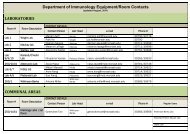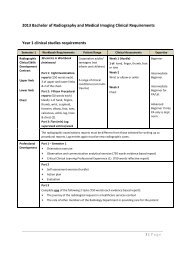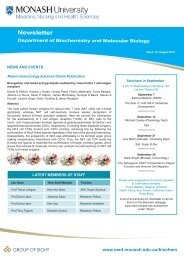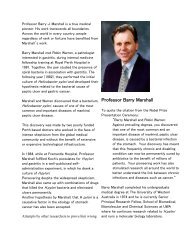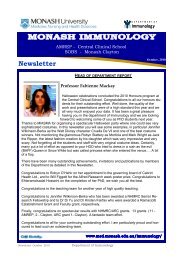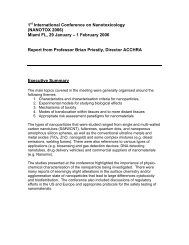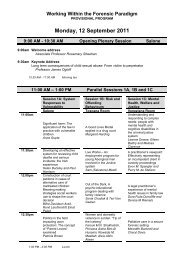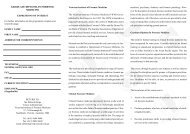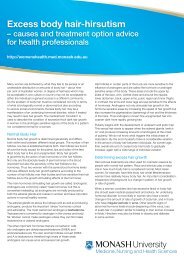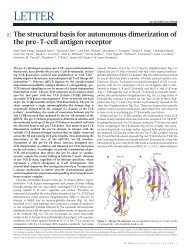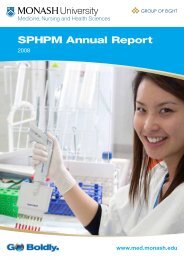Newsletter - Faculty of Medicine, Nursing and Health Sciences ...
Newsletter - Faculty of Medicine, Nursing and Health Sciences ...
Newsletter - Faculty of Medicine, Nursing and Health Sciences ...
You also want an ePaper? Increase the reach of your titles
YUMPU automatically turns print PDFs into web optimized ePapers that Google loves.
<strong>Newsletter</strong><br />
Department <strong>of</strong> Biochemistry <strong>and</strong> Molecular Biology<br />
NEWS AND EVENTS<br />
Discovery <strong>of</strong> an Archetypal Protein Transport System<br />
in Bacterial Outer Membranes<br />
Dr Joel Selkrig (Lithgow Lab) <strong>and</strong> colleagues<br />
have discovered a novel protein transport<br />
system, the translocation <strong>and</strong> assembly<br />
module (TAM).<br />
Joel summarised the discovery;<br />
“Autotransporters are bacterial virulence<br />
factors critical for the pathogenesis <strong>of</strong> many<br />
organisms. Exactly how they are assembled<br />
onto the bacterial cell surface remains<br />
contentious. We discovered a novel protein<br />
transport system, the TAM, found in most<br />
sequenced gram-negative bacteria that’s<br />
required for autotransporter biogenesis.<br />
This discovery sheds new light on how autotransporters are assembled <strong>and</strong><br />
may provide a useful target at which to aim antibacterial therapies.”<br />
Joel’s paper was discussed during the first 40 minutes <strong>of</strong> Microbe World’s<br />
broadcast TWiM #31: Screen door on a submarine, link:<br />
http://www.microbeworld.org/index.php?option=com_content&view=articl<br />
e&id=1180:twim-31-screen-door-on-a-submarine&catid=107:this-week-inmicrobiology&Itemid=275<br />
Joel Selkrig, Khedidja Mosbahi, Chaille T. Webb, Matthew J. Belous<strong>of</strong>f, Andrew J. Perry,<br />
Timothy J. Wells , Faye Morris, Denisse L. Leyton, Makrina Totsika, Minh-Duy Phan, Nermin<br />
Celik, Michelle Kelly, Clare Oates, Elizabeth L. Hartl<strong>and</strong>, Roy M. Robins-Browne, Sri Harsha<br />
Ramarathinam, Anthony W. Purcell, Mark A. Schembri, Richard A. Strugnell, Ian R. Henderson,<br />
Daniel Walker <strong>and</strong> Trevor Lithgow. Discovery <strong>of</strong> an archetypal protein transport system in<br />
bacterial outer membranes. Nat Struct Mol Biol. 2012<br />
ABSTRACT: Bacteria have mechanisms to export proteins for diverse purposes,<br />
including colonization <strong>of</strong> hosts <strong>and</strong> pathogenesis. A small number <strong>of</strong> archetypal<br />
bacterial secretion machines have been found in several groups <strong>of</strong> bacteria<br />
<strong>and</strong> mediate a fundamentally distinct secretion process. Perhaps erroneously,<br />
proteins called ‘autotransporters’ have long been thought to be one <strong>of</strong> these<br />
protein secretion systems. Mounting evidence suggests that autotransporters<br />
might be substrates to be secreted, not an autonomous transporter system. We<br />
have discovered a new translocation <strong>and</strong> assembly module (TAM) that promotes<br />
efficient secretion <strong>of</strong> autotransporters in proteobacteria. Functional analysis <strong>of</strong> the<br />
TAM in Citrobacter rodentium, Salmonella enterica <strong>and</strong> Escherichia coli showed<br />
that it consists <strong>of</strong> an Omp85-family protein, TamA, in the outer membrane <strong>and</strong><br />
TamB in the inner membrane <strong>of</strong> diverse bacterial species. The discovery <strong>of</strong> the<br />
TAM provides a new target for the development <strong>of</strong> therapies to inhibit colonization<br />
by bacterial pathogens.<br />
Seminars in May<br />
Issue 22: April 2012<br />
4 pm on Wednesdays in Building 13A,<br />
Lecture Theatre M2<br />
May 2nd<br />
A/Pr<strong>of</strong> Katharina Gaus (University <strong>of</strong> NSW)Insights<br />
into the molecular mechanisms <strong>of</strong> early T cell<br />
signalling<br />
May 9th<br />
Dr Kieran Harvey (PMCI)<br />
The Hippo pathway: organ growth <strong>and</strong> cell-fate<br />
choices<br />
May 16th<br />
Dr. Aleks<strong>and</strong>ra Filipovska (WAIMR)<br />
Regulation <strong>of</strong> the mitochondrial transcriptome<br />
****************<br />
Please send suggestions for future speakers to<br />
committee members:<br />
Travis Beddoe, Melanie Pritchard,<br />
Martin Stone, Ana Traven, Catherine Itman,<br />
Peter Boag<br />
LATEST MEMBERS OF STAFF<br />
Lab Head New Staff Member Position<br />
Dr Lee Wong Lyn Chan RF<br />
Dr Lee Wong James McGhie RA<br />
New Biochem<br />
webpage banner<br />
photo.<br />
See page 6<br />
www.med.monash.edu.au/biochem
Pr<strong>of</strong> Trevor Lithgow, an ARC Federation Fellow <strong>and</strong> Fellow <strong>of</strong> the Australian Academy <strong>of</strong> Science,<br />
was asked what it takes to become independent <strong>and</strong> what research means for him.<br />
<strong>Newsletter</strong>: April 2011, Issue 22<br />
I completed my Honours (BSc) Degree <strong>and</strong> PhD in the Biochemistry Department at La Trobe University,<br />
one <strong>of</strong> the two best Biochemistry Departments in the country. Before signing on for my PhD, I worked for<br />
two years as a research assistant with Dick Wettenhall on ribosomal protein S6 <strong>and</strong> then took six months<br />
<strong>of</strong>f, back-packing around Europe <strong>and</strong> trying to decide whether science was the right career choice for<br />
me. I learned many things as a postgraduate student, one <strong>of</strong> the most important was to never stay in<br />
one place for too long. My PhD supervisors, Nick Hoogenraad <strong>and</strong> Peter Høj, <strong>of</strong>ten talked with us about<br />
hothouse flowers, <strong>and</strong> insisted that the best move for a postdoctoral position was to go to the best place<br />
you could find overseas. The second best move for a postdoctoral position was to move to the best place<br />
you could find in Australia. There was no “third best” option that didn’t involve moving. So I read papers<br />
all around a growing interest in protein targeting, to try <strong>and</strong> work out “the best place overseas” <strong>and</strong> in the<br />
end settled on three options: Tom Silhavy’s lab at Princeton, Hugh Pelham’s lab at the LMB in Cambridge<br />
or Gottfried Schatz’s lab at the Biozentrum in Basel.<br />
In large part swayed by a beautiful study by Dietmar Vestweber who was a postdoc in the Schatz lab<br />
[1]. I started a fax correspondence with Gottfried (Jeff) Schatz. Jeff was an Austrian who had spent his<br />
postdoctoral time at several places in the United States (hence “Jeff”) <strong>and</strong> was the foundation pr<strong>of</strong>essor <strong>of</strong><br />
Biochemistry at the University <strong>of</strong> Basel’s Biozentrum. With amazing foresight, the University had purpose<br />
built the Biozentrum in 1971 to house its Departments <strong>of</strong> Biochemistry, Biophysics, Pharmacology <strong>and</strong> Cell<br />
Biology <strong>and</strong> working there was a fabulous interdisciplinary experience, well ahead <strong>of</strong> “interdisciplinary”<br />
becoming a buzz word. When I arrived in 1993, the Schatz lab had just experienced its first “golden<br />
age” sketching out the basic principles <strong>of</strong> protein targeting into mitochondria (as told by Jeff) [2]. His new<br />
generation <strong>of</strong> postdocs (there were ~12 <strong>of</strong> us in the lab at any given time over the years 1993-1995) had<br />
big shoes to fill, <strong>and</strong> we were charged with determining the mechanisms that drove this protein import<br />
pathway in mitochondria. I spent an intense <strong>and</strong> hugely rewarding time in Jeff’s lab, made some great<br />
friends <strong>and</strong> still sometimes feel home-sick for Basel. I also learned a couple <strong>of</strong> things that I continue to pass<br />
on to students <strong>and</strong> post-docs who work with me.<br />
Firstly, Peter <strong>and</strong> Nick were right. Staying at La Trobe for my postdoctoral work would not have been a<br />
good move. The Department is fabulous, but moving overseas to a different (fabulous) Department gave<br />
me experience <strong>of</strong> things that I continue to draw on today. It forced me to “grow up” as a scientist <strong>and</strong> it<br />
made me feel like a scientist – not a recently graduated student, not an apprentice in training, but part <strong>of</strong><br />
the international enterprise that is science. This will sound elitist, but science is an elite sport.<br />
Living the dream in Europe also allowed me to drop any insecurities that I’d had about whether or not I<br />
was as good as the postdocs that student-me had imagined working at places like Princeton, Cambridge<br />
etc. We don’t talk about this much, but I suspect that many Australian students have a similar cultural<br />
cringe, however unwarranted it is. You can tell yourself you’re as good as the best, other people can tell<br />
you this, but if you want to be certain that your PhD really did bring you up to scratch - to an internationallycompetitive<br />
st<strong>and</strong>ard <strong>of</strong> excellence - there is nothing like working for a few years shoulder to shoulder with<br />
the best <strong>of</strong> your peers from around the world.<br />
Department <strong>of</strong> Biochemistry <strong>and</strong> Molecular Biology<br />
University <strong>of</strong> Basel’s Biozentrum<br />
Gottfried Schatz, who elucidating the<br />
biogenesis <strong>of</strong> mitochondria <strong>and</strong> was a<br />
co-discoverer <strong>of</strong> mitochondrial DNA.<br />
The experience in Basel also showed me the value <strong>of</strong> starting in a new area. I moved away from rats <strong>and</strong> the physiology/enzymology <strong>of</strong> my PhD to a<br />
project bedded in yeast genetics. At that time, I had never seen a plate <strong>of</strong> yeast colonies <strong>and</strong> yeast genetics was as voodoo to me. But this was true<br />
for all <strong>of</strong> the postdocs that Jeff recruited. Likewise, very few <strong>of</strong> the postdocs leaving his lab after their training continued to research the same biological<br />
questions as in their postdoctoral project. Ben Glick, Sabine Rospert, Andreas Matouschek, Volker Haucke … all took what they learned in Basel <strong>and</strong><br />
started work on big, new questions when they moved back home.<br />
Important too was a lesson on success (or otherwise) with grant <strong>and</strong> fellowship applications. It is all too easy, these days included, to be dismayed<br />
by unfavourable outcomes. But chasing funding success should not be the driver for the work you will pursue or the approach you will take. I applied<br />
for three Fellowships to work in Basel: an NHMRC C.J. Martin Fellowship, a HFSP Long-term Fellowship <strong>and</strong> an EMBO Postdoctoral award. I was<br />
awarded the HFSP <strong>and</strong> EMBO Fellowships, published some pretty nice “research outcomes” <strong>and</strong> was ultimately awarded as one <strong>of</strong> the top ten<br />
postdocs in the first ten years <strong>of</strong> the HFSP. I failed to get the CJ Martin Fellowship, on the grounds that the NHMRC panel saw a lack <strong>of</strong> feasibility for<br />
success. The letter from the NHMRC was the first one I received <strong>and</strong> it was a hard knock to take. Many <strong>of</strong> us have had (<strong>and</strong> still have) many <strong>of</strong> these<br />
letters; don’t let them sway you from your course.<br />
Continued page 3<br />
Page 2
Pr<strong>of</strong> Trevor Lithgow continued<br />
TJL lab, University <strong>of</strong> Melbourne, 2004<br />
Front: Trevor, Dejan Bursac (WEHI),<br />
Lena Burri (Aker BioMarine Antarctic),<br />
Michael Dagley (McEwen Centre for<br />
Regenerative <strong>Medicine</strong>, Toronto),<br />
Katherine Vascotto (<strong>Nursing</strong>)<br />
Rear: Nickie Chan (CalTech), Joanne<br />
Hulett/Hildebr<strong>and</strong> (WEHI), Ian Gentle<br />
(University <strong>of</strong> Freiburg).<br />
TJL Lab 2012<br />
Back: Victoria Hewitt, Miguel Shingu-<br />
Vasquez, Chaille Webb, Hsin-Hui Shen<br />
Front: Trevor Lithgow, Matthew Belous<strong>of</strong>f,<br />
Denisse Leyton, Rhys Dunstan, Eva<br />
Heinz<br />
Trevor <strong>and</strong> his son, Maro.<br />
CONTACT US:<br />
Department <strong>of</strong> Biochemistry <strong>and</strong> Molecular Biology<br />
<strong>Newsletter</strong>: April 2011, Issue 22<br />
Jeff Schatz is one <strong>of</strong> the greatest advocates for teaching being part-<strong>and</strong>-parcel <strong>of</strong> research. He is famous for<br />
his lecturing workload (<strong>and</strong> the undergraduates in Basel love him) <strong>and</strong> famous too for having occasionally<br />
taken only a stick <strong>of</strong> chalk to scientific meetings for his plenary presentations. The years under his influence<br />
left me inspired <strong>and</strong> in no doubt that a teaching <strong>and</strong> research position was the career choice for me. I returned<br />
to Melbourne <strong>and</strong>, after a couple <strong>of</strong> years as a Level B Lecturer at La Trobe getting my first ARC grants to<br />
start up my own laboratory, I took a Level C position at The University <strong>of</strong> Melbourne. When I arrived, the<br />
University was planning the first inception <strong>of</strong> its Biomedical <strong>Sciences</strong> degree, <strong>and</strong> I was given the “opportunity”<br />
<strong>of</strong> designing the curriculum for three new subjects <strong>and</strong> serving as coordinator (convenor) for all three. That sort<br />
<strong>of</strong> workload should have been terrible for an ECR, but we rolled up our sleeves <strong>and</strong> ensured that three very<br />
special subjects were created. The student feedback was always very positive, <strong>and</strong> my research ran in a way<br />
that I was both happy with <strong>and</strong> proud <strong>of</strong>. I enjoyed the ten years that I spent at The University <strong>of</strong> Melbourne,<br />
<strong>and</strong> I miss teaching.<br />
Over that time the focus <strong>of</strong> research in my lab evolved from following the pathway by which relatively simple<br />
“tail-anchored proteins”, like Bcl-2 <strong>and</strong> its cousins, are inserted into the mitochondrial outer membrane, to<br />
looking at the assembly <strong>of</strong> more complex proteins <strong>of</strong> beta-barrel architecture. We identified <strong>and</strong> characterized<br />
molecular machines that drive these processes <strong>and</strong> this, in turn, led to a growing awareness that the<br />
molecular machines doing the job in mitochondria were inherited from the bacterial ancestors <strong>of</strong> these<br />
organelles.<br />
My move to our Department at Monash was made possible by an ARC Federation Fellowship awarded to<br />
investigate the bacterial <strong>and</strong> mitochondrial machines in parallel: comparing the mitochondrial system <strong>and</strong> the<br />
bacterial system for insight into evolution, for a better underst<strong>and</strong>ing <strong>of</strong> how they both function, <strong>and</strong> for any<br />
sniff <strong>of</strong> practical applications that might flow from inhibiting this process in bacterial pathogens. Our research<br />
effort is running really well, the team is smiling (pictured) <strong>and</strong> the facilities at Monash for this sort <strong>of</strong> work<br />
are better than anywhere; I honestly don’t think our current research could be done so well anywhere else.<br />
For me though, the best thing about the move to Monash was being part <strong>of</strong> the new Unit for Host-Pathogen<br />
Molecular Biology; for the collegiality between the research groups <strong>and</strong> the “buzz” <strong>of</strong> so much exciting new<br />
research. The Unit has recruited many new staff <strong>and</strong> students <strong>and</strong> has resulted in Monash securing new<br />
grants <strong>and</strong> fellowships from the ARC, NHMRC <strong>and</strong> international sources. The other five group leaders are<br />
ECRs <strong>and</strong> moved to Monash to start-up new laboratories. They have or are looking towards teaching <strong>and</strong><br />
research positions. They’ve come from training in the best labs around the world, with new ideas, new<br />
research directions <strong>and</strong> new approaches to big, exciting questions ... stop me if you think that you’ve heard<br />
this one before [3].<br />
[1] Vestweber, D., Brunner, J., Baker, A. & Schatz, G. (1989) A 42K outer-membrane protein is a component<br />
<strong>of</strong> the yeast mitochondrial protein<br />
import site. Nature 341: 205-209<br />
[2] Schatz, G. (2012) The fires <strong>of</strong> life. Annu. Rev. Biochem. 81 (in press)<br />
[3] Morrisey & Marr, J. (1987) Strangeways here we come. Sire records<br />
Pr<strong>of</strong> Lithgow’s Webpage: http://www.med.monash.edu.au/biochem/staff/lithgow.html<br />
Monash University, Ground Floor, Building 77, Wellington Road, Clayton VIC 3800 Australia<br />
Website: www.med.monash.edu.au/biochem<br />
Tel: +61 3 990 29400 Fax: +61 3 990 29500<br />
Content <strong>and</strong> Layout: Yvonne.Dooley@monash.edu Photography: MNHS Multimedia Services<br />
Department <strong>of</strong> Biochemistry <strong>and</strong> Molecular Biology<br />
Page 3
POSTGRADUATE MATTERS<br />
<strong>Faculty</strong> <strong>of</strong> <strong>Medicine</strong> Research Supervisor Accreditation Level 1<br />
Workshops - Semester 1, 2012<br />
Online Registration now open.<br />
Accreditation is compulsory for:<br />
• staff intending to supervise<br />
• postgraduate research students (with more than 25% supervision load)<br />
• all Honours student supervisors<br />
Intending research supervisors need to complete a series <strong>of</strong> nine modules.<br />
Approximately 80 per cent <strong>of</strong> the requirements <strong>of</strong> these nine modules can be covered by attendance to both <strong>of</strong> the <strong>Faculty</strong>’s Research<br />
Supervisor Accreditation Training workshops.<br />
You will need to have a mentor allocated to you by your department or centre before you may attend the workshop.<br />
These workshops are run free <strong>of</strong> charge.<br />
To apply for a place at the workshops, please register online<br />
(please note, your Monash login details will be required):<br />
http://www.mrgs.monash.edu.au/seminars/medicine/<br />
*Registrations close Monday 4th June 2012<br />
Please contact Phyllis Di Palma, (Research Degrees Office, <strong>Faculty</strong> <strong>of</strong> <strong>Medicine</strong>, <strong>Nursing</strong> & <strong>Health</strong> <strong>Sciences</strong>)<br />
on ext 20047 or email Phyllis.DiPalma@monash.edu with any queries.<br />
Dates <strong>and</strong> time <strong>of</strong> workshops<br />
The accreditation program is split into 2 workshops (attendance to both workshops is required) for prospective supervisors (Monash<br />
staff members only- your staff ID number will be required from all departments within the <strong>Faculty</strong> <strong>of</strong> <strong>Medicine</strong>, <strong>Nursing</strong> & <strong>Health</strong><br />
<strong>Sciences</strong>.<br />
Workshop 1 - Friday 8th June 2012<br />
Workshop 2 - Friday 15th June 2012<br />
Registrations from 9.20am, with each workshop concluding around 12.45pm<br />
Venue: S2 Lecture Theatre, Building 25<br />
Environmental Sustainability At Monash<br />
Anyone concerned with any environmental issues should<br />
either contact:<br />
Leigh Yang (li.yang@monash.edu)<br />
or visit The Office <strong>of</strong> Environmental Sustainability (TOES)<br />
http://www.fsd.monash.edu.au/environmental-sustainability.<br />
STUDENT SOCIETY<br />
<strong>Newsletter</strong>: April 2011, Issue 22 Department <strong>of</strong> Biochemistry <strong>and</strong> Molecular Biology<br />
Necessary Outlets for Tertiary Doctoral Research Students<br />
2012 Committee<br />
The Student Society is still in the process <strong>of</strong> establishing a new<br />
committee for this year. When this is finalised, their positions<br />
<strong>and</strong> contact details will be published.<br />
Page 4
INTRODUCING: Dr Ruby Law<br />
<strong>Newsletter</strong>: April 2011, Issue 22<br />
Background<br />
I started my research career upon accepting a postgraduate scholarship in the Yeast Molecular Biology Group at<br />
the Department <strong>of</strong> Biochemistry, Monash University, working under the supervision <strong>of</strong> Pr<strong>of</strong>essors Rodney Devenish<br />
<strong>and</strong> Phillip Nagley. This was hard-core molecular biology! My project was focused on the functional relocation <strong>of</strong><br />
mitochondrial genes into the nucleus to explore the feasibility <strong>of</strong> correcting hereditary mitochondrial gene mutations<br />
causing diseases such as diabetes, muscle pain, deafness <strong>and</strong> blindness.<br />
After leaving this exciting work, I went along to acquire more skills working in a number <strong>of</strong> biotechnology projects, one<br />
<strong>of</strong> which was to produce the human glutamic acid decarboxylase GAD65 in the Autoimmunity Group lead by Pr<strong>of</strong>essors<br />
Merrill Rowley <strong>and</strong> Ian Mackay also in the Department <strong>of</strong> Biochemistry at Monash University. GAD65 is one <strong>of</strong> the<br />
auto-antigens found in Type 1 Diabetes <strong>and</strong> Stiff Person Syndrome, <strong>and</strong> one <strong>of</strong> the key enzymes that produce gamma amino-butyric acid (GABA), a<br />
neurotransmitter inhibitor in the CNS. Our aim was to generate large quantities <strong>of</strong> GAD65 protein for potential diagnostic development <strong>and</strong> therapeutic<br />
applications. I had a fantastic time building the GAD protein production “factory” whilst juggling to raise our young family. I am still not sure which one was<br />
more tricky.<br />
After the GAD project, I decided to do something a little different – working on worms looked good. I was attracted to a parasite called liver fluke because<br />
this parasite costs millions <strong>of</strong> dollars each year through loss <strong>of</strong> livestock production, stock deaths, human infections <strong>and</strong> costs <strong>of</strong> treatment <strong>and</strong> prevention.<br />
More importantly its main effect is in poor rural communities where animals are their main source <strong>of</strong> income (e.g. Buffalo for meat, milk <strong>and</strong> to plough<br />
their rice fields). For many years, detection <strong>of</strong> liver fluke infected livestock was not possible, especially in developing countries. I joined the Molecular<br />
Parasitology Group led by Pr<strong>of</strong>essor Terry Spithill, focused on expression <strong>and</strong> purification <strong>of</strong> fluke-proteins for the development <strong>of</strong> vaccines <strong>and</strong> diagnostic<br />
kits for fluke infections. The project was very stimulating <strong>and</strong> I learnt lots about the areas <strong>of</strong> vaccine development <strong>and</strong> parasite immunology. Although we<br />
didn’t develop a commercial vaccine <strong>and</strong> work is still ongoing, I was involved in the development <strong>of</strong> a diagnostic kit now used in Indonesia. This was very<br />
satisfying <strong>and</strong> I continue to help out with this research in my spare time (which isn’t a lot!).<br />
When my old boss picked up a new post in Canada as the director for the Centre for Host-Parasite Interactions at McGill University in 2003, Pr<strong>of</strong>essor<br />
James Whisstock had just started his new Structural Biology Group in the Department. He kindly invited me to join his laboratory <strong>and</strong> I moved back to the<br />
“hard-core” research projects, firstly working part-time <strong>and</strong> then gradually full-time, <strong>and</strong> have been part <strong>of</strong> his laboratory ever since (some might say I have<br />
become part <strong>of</strong> the Monash woodwork). It has been a fascinating experience from my point <strong>of</strong> view to see how he started with 2-3 people inside Pr<strong>of</strong>essor<br />
Rob Pike’s laboratory (with one power pack) to a large <strong>and</strong> fully equipped laboratory <strong>of</strong> more than 20 people. During this time I have again reinvented<br />
myself, switching from a protein chemist to a structural biologist, thanks to James’s patience <strong>and</strong> underst<strong>and</strong>ing. During the past many years, James has<br />
been a fantastic leader <strong>and</strong> mentor <strong>and</strong> I have learnt a lot <strong>and</strong> excitingly have been involved in several high impact publications. I have also been very<br />
fortunate to work closely many extraordinary colleagues who were always ready to help <strong>and</strong> share ideas. I owe my special thanks to our very supportive<br />
team <strong>of</strong> research assistants Adam Quek, Dharsh Jeevarajah <strong>and</strong> Gordon Lloyd, as well as those who have left the laboratory to develop their careers<br />
further. Below are some <strong>of</strong> the exciting projects I am currently involved with in the Whisstock laboratory.<br />
Projects<br />
Fibrinolytic system: This work is funded by NHMRC in collaboration with A/Pr<strong>of</strong>essor Paul Coughlin <strong>and</strong> Dr Anita Horvath from the Australian Blood<br />
Disease Centre; <strong>and</strong> Drs Tom Caradoc-Davis <strong>and</strong> Nathan Cowieson from the Australian Synchrotron. Plasminogen is the zymogen form <strong>of</strong> plasmin <strong>and</strong><br />
is the most formidable protease in the plasma. It is responsible for the removal <strong>of</strong> blood clots (fibrinolysis) in the circulating system in order to maintain<br />
the blood flow. As well as that, plasminogen can also bind to the surface <strong>of</strong> cells <strong>and</strong> become activated to plasmin, which breaks down the basement<br />
membrane <strong>and</strong> extra-cellular matrix hence promotes cell migration <strong>and</strong>, in the case <strong>of</strong> cancer, cell invasion. We crystallized <strong>and</strong> determined the crystal<br />
structure <strong>of</strong> plasminogen, <strong>and</strong> the results were recently published in Cell Reports (2012). The structure reveals how circulating plasminogen resists<br />
activation until it binds to a fibrin clot or target cell surface. It also explains how pathogens (such as Streptococcus) hijack this potent plasma protease<br />
during invasion. Our current focus is to underst<strong>and</strong> the molecular interactions during plasminogen activation <strong>and</strong> plasmin inhibitions, especially in disease<br />
conditions such as thrombosis <strong>and</strong> uncontrolled bleeding. We employ various techniques including mutagenesis, characterization <strong>of</strong> enzyme activities,<br />
protein complex formation, X-ray crystallography <strong>and</strong> small angle X-ray scattering.<br />
Structure <strong>and</strong> regulation <strong>of</strong> function <strong>of</strong> human glutamic decarboxylase (GAD): Gamma aminobutyric acid (GABA) produced by GAD is the most abundant<br />
neurotransmitter inhibitor in the CNS <strong>and</strong> is critical for the control <strong>of</strong> movements, <strong>and</strong> neuroplasticity during development, learning <strong>and</strong> recovery from brain<br />
damage. Neurological conditions, such as anxiety, autism <strong>and</strong> post-traumatic stress disorder, are closely related to the imbalance <strong>of</strong> GABA homeostasis.<br />
This project is a continuation <strong>and</strong> expansion <strong>of</strong> my previous work on the GAD project with Pr<strong>of</strong>essors Merrill Rowley <strong>and</strong> Ian Mackay. We published the<br />
crystal structures <strong>of</strong> both GAD65 <strong>and</strong> GAD67 is<strong>of</strong>orms in Nature Structure <strong>and</strong> Molecular Biology (2007). We observed that the mechanism through which<br />
GABA produced in mammals is regulated by a dynamic catalytic loop. The two is<strong>of</strong>orms <strong>of</strong> GAD cooperate to meet different physiological circumstances;<br />
GAD67 is a housekeeping enzyme which maintains the basal level <strong>of</strong> GABA in the CNS <strong>and</strong> stably binds to the c<strong>of</strong>actor pyridoxal 5’ phosphate (as a holoenzyme),<br />
whilst GAD65 switches between the apo <strong>and</strong> holo-form through a process called autoinactivation. The current project studies firstly, the structural<br />
motifs involved in the autoinactivation <strong>and</strong> secondly, small molecules which can modulate the rate <strong>of</strong> GAD activity. These studies involve measuring<br />
enzyme activity <strong>and</strong> using X-ray crystallography; with our outst<strong>and</strong>ing research assistant turned PhD student Chris Langendorf being the key contributor<br />
to this project. Our aim is to comprehensively underst<strong>and</strong> the process <strong>of</strong> auto-inactivation <strong>and</strong> allosteric regulation <strong>of</strong> GAD, with the long term aim <strong>of</strong><br />
developing therapeutic treatments for GAD neurological diseases through the modulation <strong>of</strong> GAD activities.<br />
Continued page 6<br />
Department <strong>of</strong> Biochemistry <strong>and</strong> Molecular Biology<br />
Page 5
Dr Ruby Law continued<br />
Transmembrane pore formation in perforin: Perforin plays a critical role in the immune homeostasis <strong>and</strong> surveillance against viral infection <strong>and</strong> cancer cells<br />
<strong>and</strong> deficiency is associated with impaired cytotoxic T-lymphocyte function. Perforin is a pore-forming MACPF protein (Membrane Attack Complex <strong>and</strong><br />
Perforin-like) stored as a soluble conformer in the cytoplasmic granules <strong>of</strong> natural killer cells <strong>and</strong> cytotoxic T-lymphocytes. Upon conjugation with targets<br />
cells, perforin oligomerises <strong>and</strong> adopts a new conformation during pore formation. The perforin trans-membrane pores mediate the delivery <strong>of</strong> pro-apototic<br />
granzymes which induce cytolysis. In collaboration with Pr<strong>of</strong>essor Joe Trapani <strong>and</strong> Dr Ilia Voskoboinik from Peter MacCullum Cancer Research Institute,<br />
we characterized the X-ray crystal structure <strong>of</strong> the monomeric perforin. At the same time Pr<strong>of</strong>essor Helen Saibil’s group from Birkbeck College in London<br />
determined the perforin monomer <strong>and</strong> pore structure by cryo-electron microscopy. Together we were able to model how perforin assembles on the surface<br />
<strong>of</strong> the target cell upon formation <strong>of</strong> transmembrane pores; these results were published in Nature (2010). This publication is a very fulfilling outcome<br />
following our previous paper (in collaboration with Dr Michelle Dunstone) published in Science (2007) describing for the first time that the MACPF proteins<br />
including those found in the mammalian immunity defense system adopt the same fold as the bacterial cholesterol dependent cytolysins. Our current<br />
objective is to underst<strong>and</strong> at the molecular level how perforin binds to the cell membrane <strong>and</strong> forms pores on the surface <strong>of</strong> the target cells.<br />
New Biochem Webpage Banner Photo<br />
A montage depicting a model <strong>of</strong> the poxvirus immature particles combining EM <strong>and</strong> X-ray data<br />
(Hyun et al, PLoS Pathogens, 2011).<br />
The Achilles’ heel <strong>of</strong> poxviruses<br />
<strong>Newsletter</strong>: April 2011, Issue 22<br />
Department <strong>of</strong> Biochemistry <strong>and</strong> Molecular Biology<br />
In April, the new l<strong>and</strong>ing page for the Biochem<br />
website was released. All linked webpages are in<br />
the process <strong>of</strong> being updated to the new format.<br />
http://www.med.monash.edu.au/biochem/<br />
Thanks are extended to Dr Fasseli Coulibaly, who<br />
provided the current webpage banner photo<br />
We would like to change the banner photo on a<br />
regular basis. If you have photos that maintains<br />
high res at 700 x 230pixels, please forward these<br />
to yvonne.dooley@monahs.edu.<br />
Poxviruses are among the largest viruses infecting humans <strong>and</strong> have a complex architecture that sets them apart in the virus world. They<br />
produce infectious particles that, in contrast to most enveloped viruses, do not acquire their internal lipid membrane by budding through<br />
cellular compartments. Instead, poxvirus immature virions are generated from atypical crescent-shaped precursors that appear to form<br />
de novo in the cellular cytoplasm. Using a combination <strong>of</strong> X-ray crystallography <strong>and</strong> electron microscopy, we provided the first model <strong>of</strong><br />
the honeycomb scaffold at the surface <strong>of</strong> crescents <strong>and</strong> immature virions. This model establishes evolutionary links between poxviruses<br />
<strong>and</strong> viruses infecting all kingdoms <strong>of</strong> life. Importantly, it also opens new avenues to develop assembly inhibitors as antivirals against<br />
poxviruses that may emerge from an animal reservoir or be deliberately released.<br />
Courtesy: Dr Fasseli Coulibaly<br />
Research in the Coulibaly Laboratory<br />
Spheroids: crystalline armours <strong>of</strong> poxviruses<br />
Another aspect <strong>of</strong> our research focuses on in vivo crystals that represent the infectious form <strong>of</strong><br />
potential bioinsecticides including insect poxviruses. Virus particles are protected inside these<br />
crystalline armours that are remarkably stable <strong>and</strong> persist in the environment like bacterial<br />
spores. We use innovative X-ray microcrystallography to analyse crystals directly purified from<br />
infected cells <strong>and</strong> elucidate the structure <strong>of</strong> the most complex <strong>of</strong> these crystalline armours.<br />
Our research will contribute to engineering improved bioinsecticides <strong>and</strong> novel crystalline<br />
microparticles for vaccination.<br />
http://www.med.monash.edu.au/biochem/staff/coulibaly.html<br />
Page 6
FIRST AIDERS & BREATHING APPARATUS<br />
Reminder for all first aiders to update their training, <strong>and</strong> check their immunization status.<br />
The Level 2 First Aid course is to be completed every 3 years,also a CPR Refresher/Anaphylaxis every other year.<br />
Anyone interested in becoming a First Aider or a Breathing Apparatus volunteer for the department can send their request to the Safety<br />
Officer Irene Hatzinisiriou or the Deputy Safety Officer Gavin Higgins.<br />
OHS training sessions are subsidized by Monash OHS but you need to get the relevant approval <strong>and</strong> fund/cost centre numbers for the<br />
Safety Officer before applying online.<br />
Links to apply for the relevant training:<br />
CPR Refresher:<br />
http://www.adm.monash.edu.au/staff-development/ws/ohs/cpr-refresher.html<br />
Level 2 First Aider (mixed mode):<br />
http://www.adm.monash.edu.au/staff-development/ws/ohs/first-aid-mixedmode.html<br />
Breathing Apparatus:<br />
http://www.adm.monash.edu.au/staff-development/ws/ohs/breathing-apparatus.html<br />
OHS MATTERS<br />
1. Chemical Segregation<br />
Compliance is required by Victorian State Government Legislation. This has been discussed for some months now <strong>and</strong> should be<br />
completed by Easter 2012. However, there are some lab areas still working on their segregation, <strong>and</strong> hopefully we will endeavor to help<br />
them complete this process by the end <strong>of</strong> May 2012 <strong>and</strong> no later!<br />
Our Safety Officer Irene Hatzinisiriou <strong>and</strong> Deputy Safety Officer Gavin Higgins are available for consultation, guidance <strong>and</strong> assistance.<br />
The SO <strong>and</strong> deputy SO will do a quick inspection in May 2012, to ensure that all labs have implemented <strong>and</strong> are maintaining the<br />
segregation, as well to help out with any other related issues that may arise. If the SOs find that NO action has been taken. I will be<br />
asking the relevant Lab Heads for a please explain <strong>and</strong> <strong>of</strong>fering the complete removal <strong>of</strong> the relevant chemicals at the lab’s expense.<br />
2. Leave <strong>and</strong> After Hours Policy<br />
http://www.monash.edu.au/ohs/topics/procedures/after-hours.pdf<br />
A. If on “leave” (conference, sick, annual etc) you should not be engaged in laboratory research at Monash as you are not covered for<br />
insurance purposes <strong>and</strong> it is in breach <strong>of</strong> Workplace legislation.<br />
B. Normal working hours are regarded as 8am-6pm Mon-Fri. If a protocol / procedure is deemed as high risk (such as liquid Nitrogen<br />
h<strong>and</strong>ling, use <strong>of</strong> radioisotopes or primary sources <strong>of</strong> radiation, dangerous chemicals),it should only be carried out if approved by the<br />
Supervisor <strong>and</strong> the Safety Officer with the requirement that a second suitably trained person is available to assist in the case <strong>of</strong><br />
emergency. Documentation must be kept to support the granting <strong>of</strong> such approvals.<br />
Thank you for your assistance in meeting our obligations for these important matters.<br />
QUICK OVERVIEW OF WHAT TO DO WHEN AN EMERGENCY ARISES:<br />
1. Remain CALM…<br />
2. Yell out for a First Aider (don’t go looking for one yourself, get someone else to go looking)<br />
3. First Aiders: Read MSDS before treating any chemical injury<br />
4. First Aiders: Call Med Centre if necessary ext. 53175<br />
5. First Aiders: Call the Safety Officer <strong>and</strong>/or Safety Representative as soon as possible<br />
<strong>Newsletter</strong>: April 2011, Issue 22 Department <strong>of</strong> Biochemistry <strong>and</strong> Molecular Biology<br />
Page 7
SPOTLIGHT ON: Andrey Shubin<br />
Background<br />
After completing both a Bachelors <strong>and</strong><br />
Masters Degree in Chemical Technology<br />
<strong>and</strong> Biotechnology at Moscow<br />
State University <strong>of</strong> Fine Chemical<br />
Technology, I was enrolled in a PhD<br />
course in Biotechnology at the Institute<br />
<strong>of</strong> Molecular Genetics <strong>of</strong> Russian<br />
Academy <strong>of</strong> <strong>Sciences</strong> (IMG RAS). From<br />
the beginning <strong>of</strong> my research activity I<br />
have been working at the Laboratory <strong>of</strong><br />
Protein Engineering (IMG RAS) under<br />
the supervision <strong>of</strong> Dr. Ilya Demidyuk.<br />
The main objectives <strong>of</strong> investigation in<br />
our laboratory are proteolytic enzymes;<br />
with a core focus on their maturation<br />
<strong>and</strong> activation pathways, mechanisms <strong>of</strong><br />
substrate recognition <strong>and</strong> functioning, as<br />
well as possible applications <strong>of</strong> proteases<br />
in medicine <strong>and</strong> industry.<br />
My current PhD project considers<br />
proteases as potential therapeutic agents<br />
with the capability to induce death <strong>of</strong><br />
cancer cells. In the course <strong>of</strong> the project<br />
we have found that one <strong>of</strong> the tested<br />
enzymes - 3C protease <strong>of</strong> human hepatitis<br />
A virus - has a prominent cytotoxic effect,<br />
accompanied by massive cytoplasmic<br />
vacuolation. Since the vacuolation might<br />
result from the impairment <strong>of</strong> autophagy<br />
pathway <strong>and</strong> could reflect a natural<br />
role <strong>of</strong> the protease during infection, I<br />
was interested in uncovering a deeper<br />
characterisation <strong>of</strong> this effect. Luckily,<br />
due to the Australia Awards Fellowship<br />
Program, I have an excellent opportunity<br />
to carry this out at the Yeast Laboratory<br />
here at Monash University under the<br />
supervision <strong>of</strong> Pr<strong>of</strong>essor Rod Devenish.<br />
Projects<br />
All the research projects I participate<br />
in are related to different aspects <strong>of</strong><br />
proteolytic enzyme functioning. One<br />
<strong>of</strong> the investigations considers the<br />
information value <strong>of</strong> expression pr<strong>of</strong>iling<br />
<strong>of</strong> proprotein convertases (PC) <strong>and</strong><br />
matrix metalloprotease (MMP) genes in<br />
malignant tissues <strong>of</strong> human lungs. The<br />
key function <strong>of</strong> PC is processing <strong>and</strong>/<br />
<strong>Newsletter</strong>: April 2011, Issue 22<br />
or activation <strong>of</strong> numerous proteins <strong>and</strong><br />
peptides, many <strong>of</strong> which are associated<br />
with malignant diseases. MMPs are<br />
substrates <strong>of</strong> PCs <strong>and</strong> key factors in<br />
tumor invasion <strong>and</strong> metastasis. Systems<br />
<strong>of</strong> PCs <strong>and</strong> MMPs respond to malignant<br />
transformation, which suggests their<br />
expression status can be utilised as a<br />
possible marker for cancer typing <strong>and</strong><br />
prognosis. The most interesting result <strong>of</strong><br />
the project obtained so far is evidence<br />
that expression <strong>of</strong> PCs <strong>and</strong> MMPs genes<br />
in human lung tumors changes in a limited<br />
number <strong>of</strong> scenarios. These scenarios<br />
are characterised by a sharp increase<br />
in the expression level <strong>of</strong> a single PC<br />
without significant changes in expression<br />
<strong>of</strong> other proteases. We believe this result<br />
reflects the different pathways <strong>of</strong> tumor<br />
development <strong>and</strong> hope to confirm this<br />
finding in other types <strong>of</strong> cancer.<br />
Our laboratory is also focused on the<br />
investigation <strong>of</strong> the roles <strong>of</strong> propeptides<br />
in protease functioning. Most proteases<br />
are synthesised as propeptide-containing<br />
Department <strong>of</strong> Biochemistry <strong>and</strong> Molecular Biology<br />
precursors. These structural elements<br />
can determine folding <strong>of</strong> the cognate<br />
protein, function as an inhibitor/activator<br />
peptides, mediate enzyme sorting,<br />
<strong>and</strong> the interaction <strong>of</strong> a protease with<br />
other molecules <strong>and</strong> supramolecular<br />
structures. Even minor changes in<br />
propeptide structure can crucially alter<br />
protein function in the living organism.<br />
Modulatory activity coupled with<br />
high variation allows one to consider<br />
propeptides as specific evolutionary<br />
modules that can transform biological<br />
properties <strong>of</strong> proteases without significant<br />
changes in the highly conserved catalytic<br />
domains. As the considered properties <strong>of</strong><br />
propeptides are not unique to proteases,<br />
propeptide-mediated evolution seems to<br />
be a universal biological mechanism.<br />
For our investigations, we use the<br />
thermolysin-like M4 protease family<br />
as an experimental model. We have<br />
revealed that according to structure <strong>of</strong><br />
their propeptides, M4 proteases are<br />
divided into two distinct groups, even<br />
though the mature enzymes have largely<br />
similar sequences. Proteases <strong>of</strong> the first<br />
group have relatively long propeptides,<br />
are known to act as intramolecular<br />
chaperones <strong>and</strong> inhibitors <strong>of</strong> cognate<br />
mature proteins. Proteins <strong>of</strong> the second<br />
group have short propeptides <strong>and</strong><br />
resemble protealysin from Serratia<br />
proteamaculans. We have obtained a<br />
crystal structure <strong>of</strong> protealysin (which<br />
was the first example <strong>of</strong> thermolysin-like<br />
peptidase precursor crystal structure)<br />
<strong>and</strong> revealed an inhibitor function <strong>of</strong> its<br />
short propeptide. However, the existence<br />
<strong>of</strong> two different groups <strong>of</strong> propeptides<br />
makes one think that short propeptides<br />
have other specific functions which are<br />
still to be clarified.<br />
In spite <strong>of</strong> our focus in the fields mentioned<br />
above, we are always interested in<br />
collaborations <strong>and</strong> new projects related to<br />
different aspects <strong>of</strong> protease functioning<br />
<strong>and</strong> keen to broaden our research<br />
horizons.<br />
Page 8
1<br />
2<br />
3<br />
4<br />
5<br />
6<br />
7<br />
8<br />
9<br />
10<br />
11<br />
12<br />
13<br />
14<br />
15<br />
<strong>Newsletter</strong>: April 2011, Issue 22<br />
RECENT PUBLICATIONS<br />
Buckle, A.M., M.A. Bate, S. Androulakis, M. Cinquanta, J. Basquin, F. Bonneau, D.K. Chatterjee, D. Cittaro, S. Graslund, A. Gruszka,<br />
R. Page, S. Suppmann, J.X. Wheeler, D. Agostini, M. Taussig, C.F. Taylor, S.P. Bottomley, A. Villaverde, <strong>and</strong> A. de Marco, Recombinant<br />
protein quality evaluation: proposal for a minimal information st<strong>and</strong>ard. St<strong>and</strong> Genomic Sci, 2011. 5(2): p. 195-197<br />
Denton, A.E., R. Wesselingh, S. Gras, C. Guillonneau, M.R. Olson, J.D. Mintern, W. Zeng, D.C. Jackson, J. Rossjohn, 3P.D. Hodgkin,<br />
P.C. Doherty, <strong>and</strong> S.J. Turner, Affinity thresholds for naive CD8+ CTL activation by peptides <strong>and</strong> engineered influenza A viruses. J<br />
Immunol, 2011. 187(11): p. 5733-5744<br />
Heinz, E. <strong>and</strong> T. Lithgow, Back to basics: A revealing secondary reduction <strong>of</strong> the mitochondrial protein import pathway in diverse<br />
intracellular parasites. Biochim Biophys Acta, 2012 E-pub.<br />
Knaupp, A.S. <strong>and</strong> S.P. Bottomley, Structural change in beta-sheet A <strong>of</strong> Z alpha(1)-antitrypsin is responsible for accelerated<br />
polymerization <strong>and</strong> disease. J Mol Biol, 2011. 413(4): p. 888-98<br />
Ou, L., D. Duan, J. Wu, E.C. Nice, <strong>and</strong> C. Huang, The Application <strong>of</strong> High-throughput siRNA Screening Technology to Study Host-<br />
Pathogen Interactions. Comb Chem High Throughput Screen, 2012. 15(4): p. 299-205<br />
Kinross, K.M., K.G. Montgomery, M. Kleinschmidt, P. Waring, I. Ivetac, A. Tikoo, M. Saad, L. Hare, V. Roh, T. Mantamadiotis, K.E.<br />
Sheppard, G.L. Ryl<strong>and</strong>, I.G. Campbell, K.L. Gorringe, J.G. Christensen, C. Cullinane, R.J. Hicks, R.B. Pearson, R.W. Johnstone, G.A.<br />
McArthur, <strong>and</strong> W.A. Phillips, An activating Pik3ca mutation coupled with Pten loss is sufficient to initiate ovarian tumorigenesis in mice.<br />
J Clin Invest, 2012. 122(2): p. 553-7<br />
Pelosi, A., D. Smith, R. Brammananth, A. Topolska, H. Billman-Jacobe, P. Nagley, P.K. Crellin, <strong>and</strong> R.L. Coppel, Identification<br />
<strong>of</strong> a Novel Gene Product That Promotes Survival <strong>of</strong> Mycobacterium smegmatis in Macrophages. PLoS One, 2012. 7(2): p. e31788<br />
[MICRO,BCH]<br />
Poreba, M., S. McGowan, T.S. Skinner-Adams, K.R. Trenholme, D.L. Gardiner, J.C. Whisstock, J. To, G.S. Salvesen, J.P. Dalton, <strong>and</strong><br />
M. Drag, Fingerprinting the Substrate Specificity <strong>of</strong> M1 <strong>and</strong> M17 Aminopeptidases <strong>of</strong> Human Malaria, Plasmodium falciparum. PLoS<br />
One, 2012. 7(2): p. e31938<br />
Rada, P., P. Dolezal, P.L. Jedelsky, D. Bursac, A.J. Perry, M. Sedinova, K. Smiskova, M. Novotny, N.C. Beltran, I. Hrdy, T. Lithgow, <strong>and</strong><br />
J. Tachezy, The core components <strong>of</strong> organelle biogenesis <strong>and</strong> membrane transport in the hydrogenosomes <strong>of</strong> Trichomonas vaginalis.<br />
PLoS One, 2011. 6(9): p. e24428<br />
Reantragoon, R., L. Kjer-Nielsen, O. Patel, Z. Chen, P.T. Illing, M. Bhati, L. Kostenko, M. Bharadwaj, B. Meehan, T.H. Hansen, D.I.<br />
Godfrey, J. Rossjohn, <strong>and</strong> J. McCluskey, Structural insight into MR1-mediated recognition <strong>of</strong> the mucosal associated invariant T cell<br />
receptor. J Exp Med, 2012. 209(4): p. 761-74<br />
Tilkorn, D.J., E.M. Davies, E. Keramidaris, A.M. Dingle, Y.W. Gerr<strong>and</strong>, C.J. Taylor, X.L. Han, J.A. Palmer, A.J. Penington, C.A. Mitchell,<br />
W.A. Morrison, G.J. Dusting, <strong>and</strong> G.M. Mitchell, The in vitro preconditioning <strong>of</strong> myoblasts to enhance subsequent survival in an in vivo<br />
tissue engineering chamber model. Biomaterials, 2012. E-pub: p. 1-12<br />
Wagstaff, K.M., H. Sivakumaran, S.M. Heaton, D. Harrich, <strong>and</strong> D.A. Jans, Ivermectin is a specific inhibitor <strong>of</strong> importin alpha/betamediated<br />
nuclear import able to inhibit replication <strong>of</strong> HIV-1 <strong>and</strong> dengue virus. Biochem J, 2012. 443(3): p. 851-856<br />
Wu, J., N. Xie, X. Zhao, E.C. Nice, <strong>and</strong> C. Huang, Dissection <strong>of</strong> aberrant GPCR signaling in tumorigenesis--a systems biology approach.<br />
Cancer Genomics Proteomics, 2012. 9(1): p. 37-50<br />
Yoga, Y.M., D.A. Traore, M. Sidiqi, C. Szeto, N.R. Pendini, A. Barker, P.J. Leedman, J.A. Wilce, <strong>and</strong> M.C. Wilce, Contribution <strong>of</strong> the<br />
first K-homology domain <strong>of</strong> poly(C)-binding protein 1 to its affinity <strong>and</strong> specificity for C-rich oligonucleotides. Nucleic Acids Res, 2012.<br />
E-pub: p. 1-14<br />
Zhou, Y., Y.S. Zhou, F. He, J. Song, <strong>and</strong> Z. Zhang, Can simple codon pair usage predict protein-protein interaction? Mol Biosyst, 2012.<br />
E-pub<br />
Department <strong>of</strong> Biochemistry <strong>and</strong> Molecular Biology<br />
Page 9




